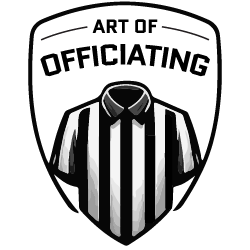Press coverage is a defensive technique used by defensive backs (DBs) to tightly cover a wide receiver at the line of scrimmage. The goal is to disrupt the receiver’s timing, release, and route by using physical contact or “jamming” him at the snap.
This is a high-risk, high-reward alignment and is usually employed when the defender is physically superior to the receiver. Effective press coverage can take away quick throws and disrupt timing, but if the receiver beats the jam, it can leave the defender trailing with little help.
We need to understand NFHS rules to properly officiate the contact between the defensive back and the receiver.
Rule 7-1-6a: The defensive back cannot break the plane of the neutral zone.
If the DB is in the neutral zone and the snap is not imminent, use your voice to tell the DB to get back. Don’t just throw a flag without trying to get the DB to move back a bit. Worse yet, don’t stand passively and then throw a flag at the snap if you judge the DB was in the neutral zone. Encroachment is not a live-ball foul, so if you’re going to get it, you need to get it before the snap. If you cannot communicate with the DB before the snap and you judge he was in the neutral zone and his physical location provided him a competitive advantage, you should flag him for encroachment.
Rule 9-2-3d: A defensive player shall not contact an eligible receiver who is no longer a potential blocker
At the snap, the DB doesn’t know if the receiver is blocking during a running play or attempting to run a pass route. The DB can contact the receiver until it is clear the receiver is no longer a potential blocker. One rule of thumb we use is: when the receiver is on the same relative yard line as the DB, he is no longer a potential blocker.
Rule 9-2-3c: A defensive player shall not use his hands or arms to hook, lock, clamp, grasp, encircle or hold in an effort to restrain an opponent other than the runner
This is clear. The DB cannot restrain the receiver from running a pass route. If the restraint is before the pass leaves the QB’s hand, the DB is guilty of holding. If the restraint occurs while the ball is in flight, the DB is guilty of defensive pass interference.
Rule 2-3-5a: A defensive player may use unlocked hands, hand, or arm to ward off an opponent who is blocking him or is attempting to block him
Rule 2-3-5b: A defensive player may push, pull, or ward off an opponent in an actual attempt to get at the runner
If the QB rolls to the DB’s side, the DB does not know if the QB will keep the ball or if he is rolling out to pass the ball. If the receiver makes contact, the DB can push, pull, or ward off the receiver to try to get to the QB. If the receiver makes contact and then tries to run a route, the DB cannot restrain him.
Rule 7-5-11b: It is not forward-pass interference if contact by A is immediately made on a B lineman and the contact does not continue beyond the expanded neutral zone.
The DB is on his line of scrimmage if he is within 1 yard of the LOS at the snap (2-25-3). If he is within 1 yard of the LOS, the DB is a lineman (for rules purposes), not a DB. If the defensive player is in press coverage (and within 1 yard of the LOS at the snap), the receiver can drive his opponent (who is legally a lineman) backward, knock the defensive player to the ground, and then run a pass route.
The receiver cannot continue to contact the defensive player (who was a lineman at the snap) beyond the expanded neutral zone and then run a pass route if a legal forward pass crosses the neutral zone. This would be offensive pass interference.
If the defensive back is in press coverage, but NOT within 1 yard of the LOS at the snap, the receiver cannot contact the defensive back and then run a pass route if the legal forward pass crosses the neutral zone.
Quiz
Read the quiz stem and then choose the best answer.
3/6 from the B-20. A33 is hit at the B-22 and fumbles. To keep the ball from a Team B recovery, A47 bats the ball at the B-25. A17 falls on the ball at the B-28. If Team B elects to enforce the penalty, on which yard line will A47’s illegal batting foul be enforced?
- B-28 (dead ball spot)
- B-25 (spot of the foul)
- B-22 (end of the run)
- B-20 (previous spot)
Review Rules 2-33-1c, 10-4-2b and 10-4-4a
